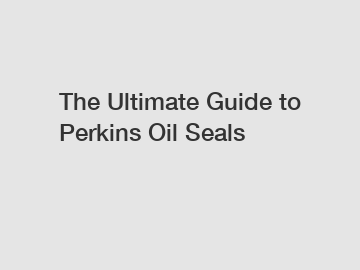The Ultimate Guide to Perkins Oil Seals
When it comes to engine maintenance, one component that plays a crucial role in preventing oil leakage and ensuring optimal performance is the oil seal. In this comprehensive guide, we delve into the world of Perkins oil seals, exploring their importance, functions, and how to choose the right ones for your engine. Whether you're a seasoned mechanic or an aspiring DIY enthusiast, this ultimate guide will equip you with the knowledge and expertise needed to keep your engine running smoothly.
1. Understanding Perkins Oil Seals:
Perkins oil seals are renowned for their quality and durability, serving as a critical barrier between the engine's internal components and the outside environment. These seals effectively prevent the leakage of oil and contaminants, ensuring that the engine's vital parts remain properly lubricated and protected.

2. The Importance of Quality Oil Seals:
When it comes to engine maintenance, compromising on the quality of oil seals is a recipe for disaster. Poorly designed or substandard seals can lead to oil leaks, which not only negatively impact engine performance but can also cause extensive damage over time. By investing in high-quality Perkins oil seals, you can be confident in the reliability and longevity of your engine.
3. Factors to Consider when Choosing Perkins Oil Seals:
a) Compatibility: The first step in selecting the right oil seal is ensuring compatibility with your engine make and model. Perkins offers a wide range of seals tailored to fit various engines, so take the time to research and choose the one that matches your specific requirements.
b) Material: Perkins oil seals are commonly made from materials such as Nitrile or Viton. While Nitrile is known for its general-purpose functionality, Viton offers enhanced resistance to heat, chemicals, and extreme temperatures. Depending on your engine's operating conditions, it's important to choose the appropriate material for optimal performance.
c) Dimensions and Specifications: Size matters when it comes to oil seals. Carefully measure the shaft diameter, internal bore diameter, and width to ensure a perfect fit. Consider the operating temperature range as well, as certain seals are designed to withstand higher temperatures and extreme conditions.
4. Proper Installation and Maintenance:
a) Preparation: Before installing a new oil seal, it's essential to clean the area thoroughly and remove any remnants of the old seal. Adequate surface preparation ensures a secure fit and prevents potential leaks.
b) Lubrication: Applying a thin layer of oil lubricant to the seal and the surrounding area helps reduce friction during installation. This step is crucial to ensure a smooth and seamless fit.
c) Installation Techniques: Whether you choose to use a specialized tool or carefully tap the seal into place, it's crucial to avoid damaging the seal during installation. Precision and attention to detail are key to achieving a leak-free seal.
d) Inspections and Replacements: Regular inspections of oil seals, especially during routine maintenance, can help detect any signs of wear or damage. If you notice oil leaks or any other issues, it's important to replace the seal promptly to prevent more extensive damage to the engine.
Conclusion:
Proper engine maintenance plays a vital role in the longevity and performance of your vehicle, and Perkins oil seals are an indispensable component in this process. By understanding the importance of quality seals, selecting the right ones, and ensuring proper installation and maintenance, you can be confident that your engine remains in peak condition.
Remember, if you're unsure about any aspect of oil seal replacement or maintenance, it's always best to consult a qualified mechanic. The expertise and experience they bring to the table are invaluable when it comes to keeping your engine running smoothly.
If you are looking for more details, kindly visit cfw sealing, cn factory, copper crush washer kit.


